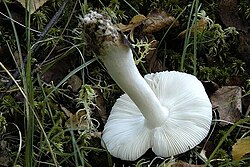| Russula versicolor | |
|---|---|
 | |
| Scientific classification | |
| Kingdom: | Fungi |
| Division: | Basidiomycota |
| Class: | Agaricomycetes |
| Order: | Russulales |
| Family: | Russulaceae |
| Genus: | Russula |
| Species: | R. versicolor |
| Binomial name | |
| Russula versicolor Jul.Schäff. (1931) | |
Russula versicolor, commonly known as the birch brittlegill, [1] is a mushroom in the genus Russula . It is considered inedible. [2]